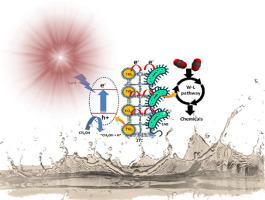Molecular Catalysis ( IF 4.6 ) Pub Date : 2021-08-28 , DOI: 10.1016/j.mcat.2021.111845 Prakash C. Sahoo 1 , Amardeep Singh 1 , Manoj Kumar 1 , R.P. Gupta 1 , S.K. Puri 1 , S.S.V. Ramakumar 1

|
Recently, photosynthetic biohybrid systems are emerged as efficient catalytic materials having advantages of the light-harvesting ability of semiconductors and the catalytic efficiency of biological system. In this context, a stable visible light active Zn-metal organic framework (ZTC) functionalized with TiO2 (ZTC@TiO2) was synthesized, and synergistically integrated with an electroactive microbial (EAB) system for efficient CO2 reduction under visible-light illumination. The resultant bio-hybrid shows remarkably higher CO2 reduction under visible light irradiation as compared to independent ZTC@TiO2 and microbe system. Under optimized condition, the bioinorganic hybrid (EAB-ZTC@TiO2) shows a CO2 conversion to acetic acid and methanol with a higher selectivity towards methanol. The improved photocatalytic CO2 conversion and selectivity towards methanol is ascribed to a well-organized donor-acceptor interfacial charge transfer from ZTC@TiO2 to a microbe, which effectively activates the Wood-Ljungdahl pathway of microbes, thereby improving the CO2 reduction efficiency.
中文翻译:

金属有机骨架敏化电活性微生物光增强 CO2 转化
近年来,光合生物杂化系统作为一种高效的催化材料出现,具有半导体的光捕获能力和生物系统的催化效率的优点。在此背景下,合成了稳定的可见光活性锌金属有机骨架 (ZTC) 功能化的 TiO 2 (ZTC@TiO 2 ),并与电活性微生物 (EAB) 系统协同集成以在可见光下有效还原CO 2照明。与独立的 ZTC@TiO 2和微生物系统相比,所得生物杂化物在可见光照射下表现出显着更高的 CO 2还原。在优化条件下,生物无机杂化物(EAB-ZTC@TiO 2)显示了CO 2向乙酸和甲醇的转化,对甲醇具有更高的选择性。改进的光催化 CO 2转化率和对甲醇的选择性归因于从 ZTC@TiO 2到微生物的有序供体-受体界面电荷转移,有效激活微生物的 Wood-Ljungdahl 途径,从而提高 CO 2还原效率.



























 京公网安备 11010802027423号
京公网安备 11010802027423号